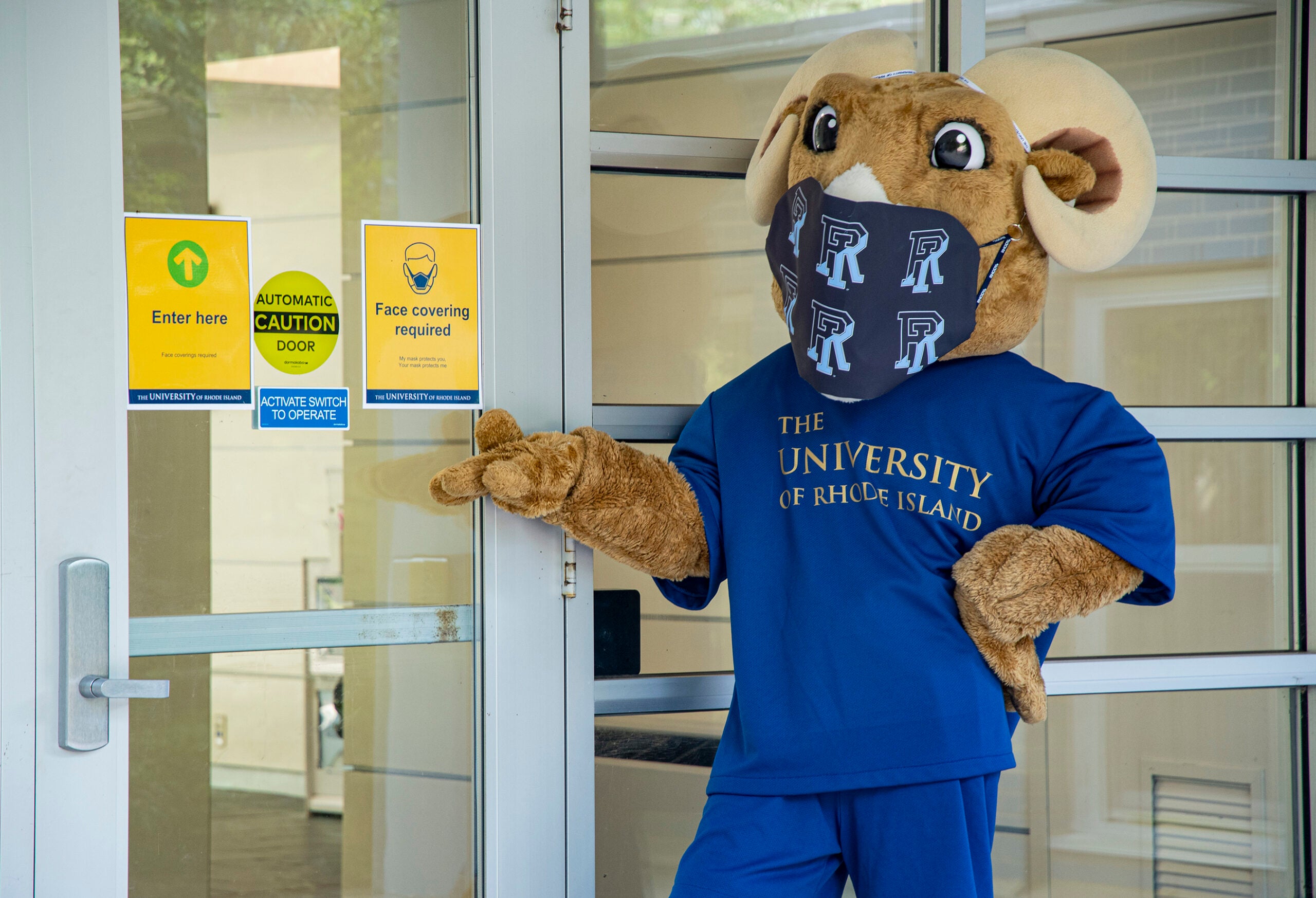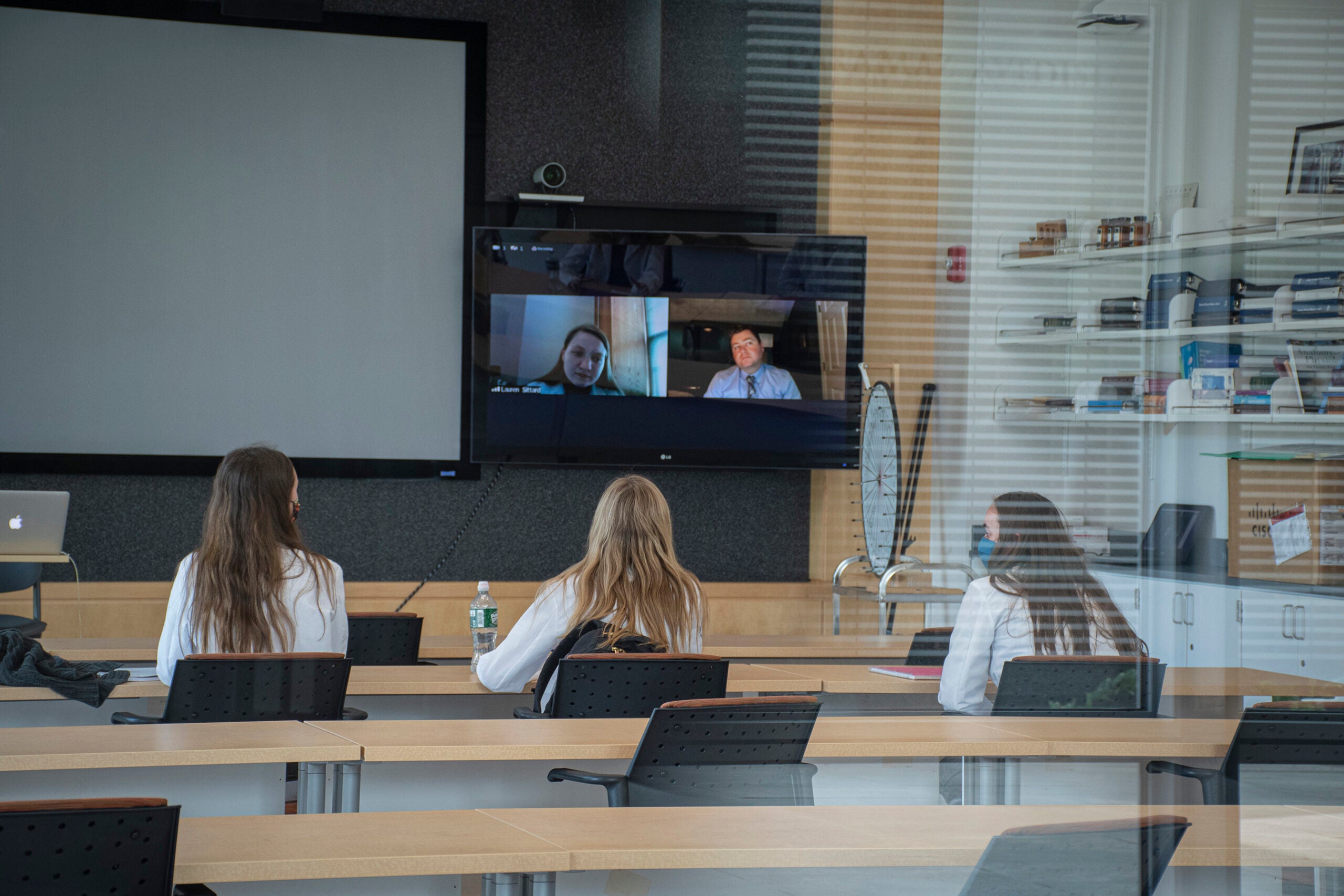KINGSTON, R.I. — February 3, 2021 — When the University of Rhode Island decided to bring students back in the fall, it looked to groups that operate with little fanfare to make it happen.
Much of it was truly heavy lifting, as crews from Facilities Operations removed tons of furniture to reduce the number of students allowed in classrooms and common spaces. At the same time, they joined staff from Information Technology Services to install and activate $1.6 million in new technology to give professors the tools they needed to successfully teach blended and online classes.
From a massive purchasing effort to locate needed supplies to building and installing 1,500 hand sanitizing stations in a matter of days, to supporting hundreds of training sessions for faculty and staff, there was little that these groups did not undertake to keep URI operational.

And with barely a break from the completion of the fall semester, they are at it again with the spring semester now underway. Praise for their work has come from all quarters.
“2020 was a year of learning while doing: we learned to work remotely, sanitize classrooms to the highest degree possible, set up testing centers, locate scarce supplies, maximize interior air circulation, deliver mail in a new way, create new traffic patterns, track specific types of expenditures for COVID-19 reimbursement, and rethink the way we do literally everything,” said Abigail Rider, vice president for Administration and Finance.
“We kept the University running smoothly and looking fabulous. I am very proud of the many, many ways, large and small, that our staff made it possible for the University to deliver an in-person semester of quality education to our students and for the University’s important research to carry on. It’s wonderful to be part of a tight-knit community like ours.”
“We have six different facilities operations at URI’s four campuses (including housing and dining), and we all needed to come together so that we could make purchases of hand sanitizers, sanitizing wipes, personal protective equipment and cleaning supplies more efficient,” said Sam Adams, ‘23 Ph.D., director of Emergency Management. “We did that in so many areas, and staff members were great about crossing divisional lines.”
For instance, Jeffrey Ulricksen, manager of space allocation and analysis, worked hand-in-hand with Adams, Dean Libutti, M.B.A. ‘95, vice provost for Enrollment Management, and a team of students in late summer to hand-count every classroom seat for distancing purposes and get each building fully and safely ready for students and faculty. Then it was on Ulricksen’s team to move furniture and equipment to get to a safe number.
In addition, without increasing his 100-person custodial staff, Karl Calvo, assistant vice president for the Facilities Group, increased classroom cleanings from once to twice a day, including a once-daily cleaning with hydrostatic cleaners, which charge droplets that repel one another and then actively seek out and disinfect surfaces, coating all sides of desks, chairs and tables.
With the dining halls closed to in-person dining, trash started to build up in residence halls as more students brought their grab-and-go meals back to their rooms. Kathy Collins, vice president of Student Affairs, said it could have been a big problem if not for the support of Abigail Rider and David Lamb, ‘84, director of Facilities Operations, who marshaled their units to provide more frequent trash pickup.
Adams said Budget and Financial Planning Director Linda Barrett ‘73, and Purchasing Director Tracey Angell made sure the procurement process ran smoothly.
“No one ever denied a request I made,” Adams said. “We avoided cash-flow bottlenecks.”
“We were worried about getting (cleaning and sanitizing) supplies,” Calvo said, “and about our custodians getting sick. Gloves and masks were a big deal. Some vendors never delivered, and we had to stay on that. But, we knew this was going to worsen, so we went out and bought a lot of supplies. We were a little bit ahead of the game.”
On the Information Technology Services side, ITS Teaching and Learning Services, Service Desk and Audio Visual departments had a monster task before them even before the fall semester arrived. They helped all 700-plus, full-time teaching faculty move to remote learning in the span of two weeks as the University switched to all online learning after spring break 2020.
Then, with Bob Viens, associate director of community computer services, and Mark Oliver, ‘85, M.B.A. ‘07, an ITS manager, at the helm, they went from that effort to working long days, including weekends, to support multiple initiatives and train about 2,000 (faculty and staff participants) on Webex and Zoom remote conferencing tools in preparation for the fall. The audio visual team and its facilities partner did not take a day off all summer as they converted classrooms for the fall semester.
They did all this while transitioning from the Sakai learning management system to Brightspace, migrating students to a new email domain that linked with Brightspace, rolling out a new URI mobile app, moving to a fully virtual service desk and rolling out a completely revamped main IT website.
ITS, with assistance from the web team in Marketing and Communications, also launched its new COVID-19 website in 48 hours, which had about 5,000 hits in its first week.
Katie Babula ‘11, manager of the AV department of ITS, said the University accelerated its 21st Century Classroom initiative and installed the latest technology in 110 classrooms, which allows teachers to either stream lectures to students who choose to learn remotely, but also allows teachers to teach from home or the classroom and share that lesson simultaneously with the classroom.
“This was a prime example of how the University advanced through the crisis while maintaining its strategic focus,” said Karlis Kaugars, chief information officer and head of Information Technology Services. “This advanced the president’s goal of the 21st century learning environment by leaps and bounds.”
“We had to do design, procurement, installation, programming and training in about two months,” Babula said. “The team worked weekends, holidays, and many long days.”
Michelle Rogers-Estable, director of Teaching and Learning Services, said the volume of technology and training support provided to faculty and staff could get overwhelming.
“Not only did we have to start supporting four times as many people using our systems, but we had to support four times as many people who needed help getting migrated over or moving content over or getting used to a new system,” Rogers-Estable said.
Kaugars said every member of the ITS team put great effort into assisting faculty, staff and students during the spring and fall semesters. In addition to the team members mentioned earlier, they include: Terry Wild ‘87, M.B.A. ‘03, manager of the Service Desk; Michael Khalfayan, chief information security officer; Donna Belden ‘77, associate director of administrative computing systems; Mike Motta M.O.A. ‘09, associate director of IT service administration; Cathy White, lead programmer analyst; and Mark Fester, associate director, networking.
Public Information Officers Dawn Bergantino and Tony LaRoche contributed to this story.

